Catastrophe of the Don Cossacks
At the end of 1918 - the beginning of 1919, the Tsaritsyn front of the White Cossacks fell apart. In January, 1919, the third assault on the red Tsaritsyn failed. The mutiny of several Cossack regiments, tired of war, began. In February, the Cossack Don Army retreated from Tsaritsyn. The Cossack army collapsed, the Cossacks went home or went over to the Reds. The troops of the Southern Front of the Red Army again occupied the lands of the Don Region. The victorious red did not stand on ceremony with the Cossacks. Red terror, raskazachivanie and ordinary robbery caused a response. The Don Cossacks soon rebelled again.
prehistory
After the February Revolution, the collapse of the Russian Empire began. Don Cossacks did not remain aloof from this process and raised the question of the autonomy of the Region of the Don Army. Ataman was elected to General Kaledin. After October, the situation on the Don strained even more. The military (Don) government refused to recognize the power of the Bolsheviks and began the process of liquidation of Soviet power in the region. The Don Region was proclaimed independent before the formation of a legitimate Russian government. In November, General Alekseev arrived in Novocherkassk on November 10, the process of creating volunteer formations for war with the Bolsheviks (the Volunteer Army) began.
In late November - early December 1917, the Kaledin government with the help of volunteers (most of the Cossack troops assumed neutrality and refused to fight) suppressed the Bolshevik uprising. Kaledinians took control of Rostov-on-Don, Taganrog and a significant part of the Donbass. Kaledin, Alekseev and Kornilov created the so-called. "Triumvirate", claiming the role of the all-Russian government. Officially announced the creation of the Volunteer Army.
However, the "triumvirate" had a weak social base. Many officers took the position of non-intervention, not wanting to fight. The position of neutrality was also taken by most of the Don Cossacks. Cossacks are already tired of war. Many Cossacks were attracted by Bolshevik slogans. Others hoped that the conflict concerns only the Bolsheviks and volunteers (whites), and they will remain on the sidelines. That the Don region will be able to come to terms with the Soviet government.
The Bolsheviks in December 1917 created the Southern Front of the Red Army and launched an offensive. The bulk of the Don Cossacks did not want to fight. Therefore, Kaledinians and Alekseevs suffered a defeat. In February, the 1918 of the Reds occupied Taganrog, Rostov and Novocherkassk. Alekseev and Kornilov, seeing that the situation was hopeless, increased their forces to Kuban (the First Kuban campaign), hoping to raise the Kuban Cossacks and create a new base for the Volunteer Army. Kaledin committed suicide. The irreconcilable Cossacks, led by General Popov, went to the Salsk steppes.
In March, 1918, the Don Soviet Republic was proclaimed on the territory of the Don Cossacks. Her head was the Cossack Podtylokov. However, the Soviet government lasted on the Don only until May. The policy of land redistribution, with the seizure of "nonresident" peasants of Cossack lands, looting and terror by the Red troops, which then often did not differ from the usual gangsters, led to elemental Cossack riots. In April, 1918, based on the rebel detachments and the returning Popov detachment, began the process of creating the Don Army. The Cossacks were helped by a favorable military-political situation. In the course of the intervention, the Austro-German army pushed the Red detachments back to the beginning of May and reached the western part of the Don Region, capturing Rostov-on-Don, Taganrog, Millerovo and Chertkovo. Returned from the unsuccessful campaign of the Kuban Volunteer Army. From Romania, a white detachment of Drozdovsky made a hike and helped the Cossacks take 7 to Novocherkassk. The Don Soviet Republic was destroyed.
The new Don government in May 1918 was headed by ataman Krasnov. The government of Krasnov and the command of the Volunteer Army did not unite. First of all. Krasnov was guided by Germany, and Alekseev and Denikin (Kornilov died) - by the Entente. Krasnov proclaimed the creation of an independent Cossack republic, and hoped to create a confederation with Ukraine and the Kuban. The volunteers who stood for “united and indivisible” Russia were against such a policy. Secondly, the Don government and the command of the Volunteer Army dispersed on the issue of military strategy. Red offered to go to Tsaritsyn, to the Volga, to unite with the anti-Bolshevik forces in the east of Russia. Also, the Don government planned to expand the boundaries of its “republic”. The volunteers decided to go again to the Kuban and the North Caucasus, destroy the Reds there and create a rear base and a strategic base for further hostilities.
Since the enemy was common, Krasnov and Alekseev became allies. In June 1918, the Volunteer Army launched the Second Kuban campaign. The Don Army launched an offensive on the Voronezh and Tsaritsyn axes. The Don Region was the rear of the Volunteer Army while it was fighting in the Kuban and the North Caucasus. Don government supplied volunteers weapons and ammunition received from the Germans.
In July - early September and September - October 1918, the Don Army stormed Tsaritsyn twice. The Cossacks were close to victory, but the Red Command took extraordinary measures and repelled enemy attacks. The Tsaritsyn assault failed, the Cossacks retreated beyond the Don.
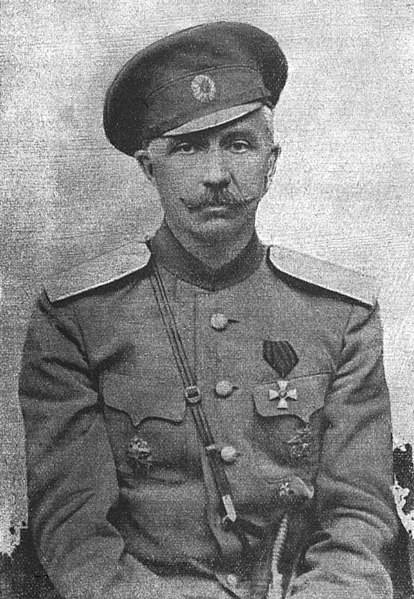
Ataman of the Great Don Army, cavalry general P. N. Krasnov
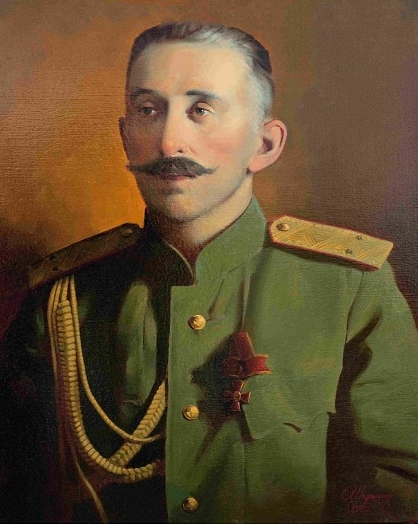
Commander of the Don Army Svyatoslav Varlamovich Denisov
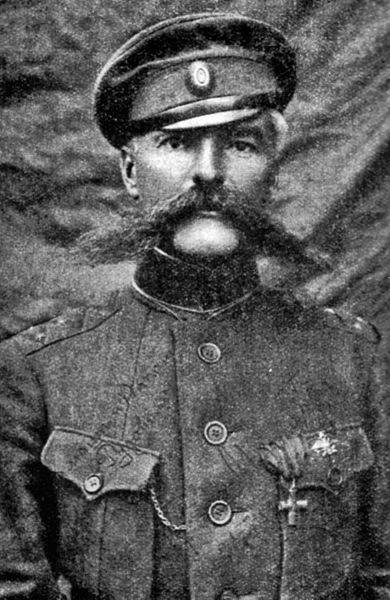
The military leader of the Don Army Konstantin Konstantinovich Mamontov (Mamantov)
Catastrophe of the Don Army
In November, 1918 of the Year capitulated to Germany, the patron of the government of Krasnov. The victory of the Entente radically changed the military-strategic situation in the South of Russia. German troops began to evacuate from the western part of the Don region and Little Russia, opening the left flank of the Cossack republic to the Red Army. The front line for the Cossacks immediately increased by 600 km. The influx of weapons and ammunition purchased by the Don government from the Germans stopped. The Cossacks kept already from the last forces, attacked only on the Tsaritsin direction. The winter was harsh, snowy and frosty. An epidemic of typhus has come to the Don. The fighting was no longer due to tactical considerations, but simply for housing, the ability to live under the roof, in the heat. Krasnov tried to negotiate with the Entente, but did not recognize his power.
After the evacuation of the German army, a huge breach formed on the left flank of the Don Republic. And she came to the industrial, mining area, where the Red Guard detachments began to appear again. Makhno troops were threatened from Tavria. The troops of the 8 th Red Army began moving south. The Cossacks had to urgently withdraw two divisions from the Tsaritsyn Front to occupy Lugansk, Debaltseve and Mariupol. But this was not enough, the Cossacks created a rare veil. Krasnov asked for help from Denikin. He sent an infantry division May-Mayevsky. In the middle of December, Denikinites landed in Taganrog and occupied a section of the front from Mariupol to Yuzovka. Also, white detachments were sent to the Crimea, Northern Tavria and Odessa.
In January 1919, the Don Cossacks organized the third attack on Tsaritsyn, but it ended in defeat. The failures of the Don Army near Tsaritsyn, the disintegration of the Cossack troops, the victories of volunteers in the Kuban and the North Caucasus, and the appearance of the Entente troops in the South of Russia forced Krasnov to recognize the primacy of Denikin. In January, the 1919 was formed by the Armed Forces of the South of Russia (the Volunteer and Don armies) led by Denikin.
Simultaneously with the attack on the west of Russia and in Ukraine, Ukraine, the Red Command decided to put an end to the center of counter-revolution in the south with a powerful blow. In January, 1919, the troops of the Southern Front of the Red Army launched an offensive with the aim of defeating the Don Army and liberating Donbass. Additional forces were redeployed from the Eastern Front, where during this period the Reds won victories on the Volga and the Urals. In the west, the Kozhevnikov group was deployed, the future 13-I Red Army, in the north-west there was the 8-I army, in the north - the 9-I army. The 10-I army of Egorov was advancing from the east, she had to cut off the Don from the Kuban. The total number of red troops exceeded 120 thousand bayonets and sabers with 468 guns. The Don Army numbered about 60 thousand fighters with 80 guns.
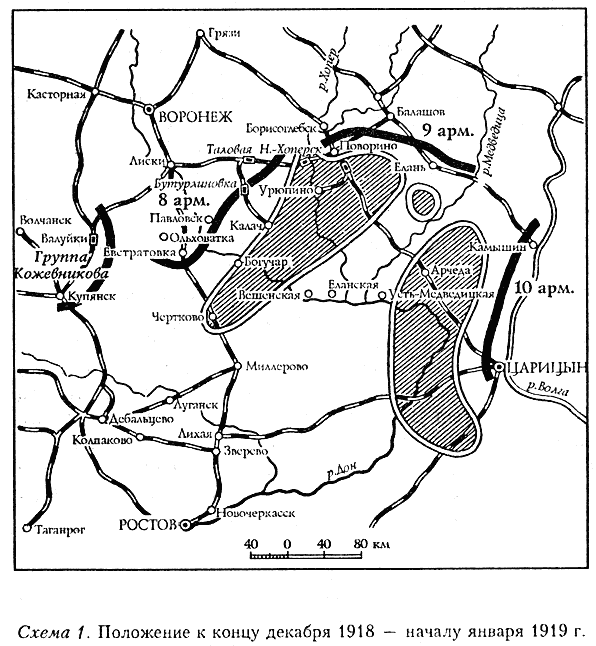
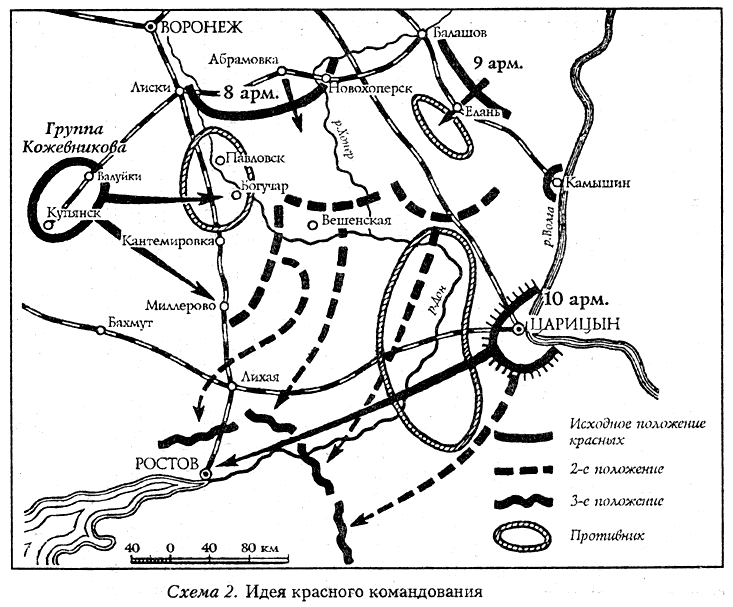
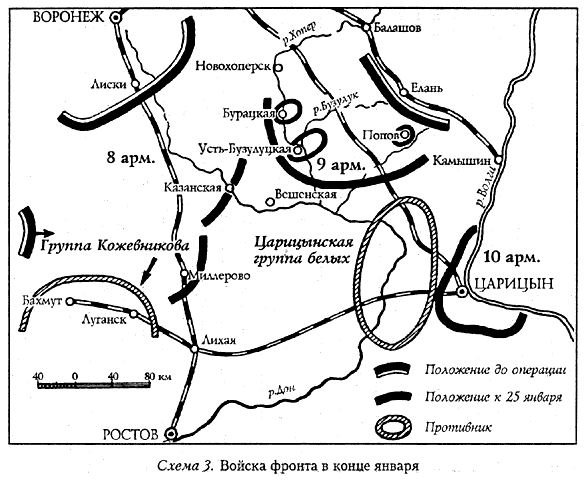
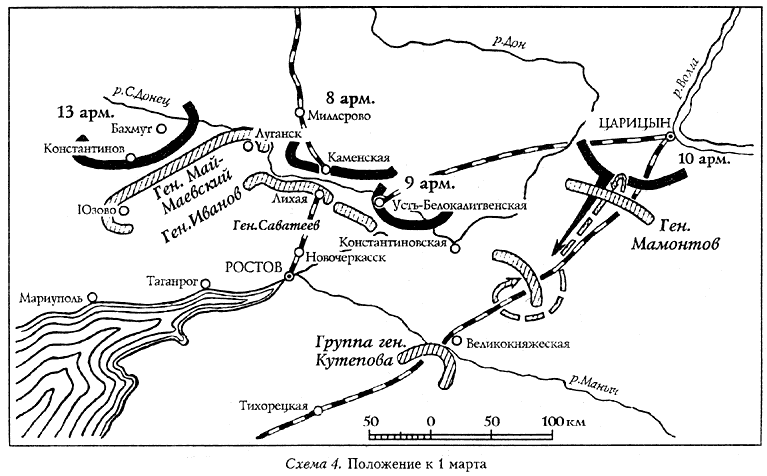
Source: A. Egorov. Civil war in Russia: The defeat of Denikin. M., 2003.
At first, the Cossacks held out and even attacked. The offensive of the 10 Red Army was repelled. Parts of Mamontov broke through the front, and the Don Cossacks approached Tsaritsyn for the third time. In the west, the Cossacks, with the support of the Whites, also held out — the Konovalov group and the May-Mayevsky division. The Reds here constantly increased the onslaught at the expense of the Red Guard and Makhnovist workers. However, Krasnov conducted a new mobilization, and Denikin sent reinforcements.
The front collapsed in the northern sector, on the Voronezh direction. Here the Cossacks were demoralized by constant battles, parts of them could not be replaced. The same regiments were transferred from one dangerous area to another. Severe winter, typhus. Krasnov promised help to the Germans, the Entente and the Whites, but she was not there. The Bolsheviks stepped up campaigning, promising peace. As a result, the Cossacks revolted. In January, 1919, the 28 of the Upper Donskoy, Kazansky and Migulinsky regiments, rallied, threw the front and went home "to celebrate the Feast of Christ." Soon the front left and 32-th regiment. The Cossacks of the 28 Regiment decided to make peace with the Bolsheviks and seize the "cadet" headquarters in Vyoshenskaya. Fomin was elected commander, Melnikov was appointed commissioner. On January 14, the thinned regiment (many fled) entered Vyoshenskaya, although it was in no hurry to attack the headquarters of the Northern Front, led by General Ivanov. The Cossacks did not want to fight with their own. But Ivanov did not have the strength to suppress the rebellion. As a result, the front headquarters moved to Karginskaya. The connection of the headquarters with the troops and their management was broken. Krasnov also did not have a reserve to build a rebellion, all the troops were at the front. The Atman tried to persuade the Cossacks, but he was sent in Russian swearing.
Krasnov was accused of betraying the "labor Cossacks", the Cossacks recognized the Soviet government, and Fomin began negotiations with the reds about peace. The departure of several regiments from the front created a big gap. The 9 Red Army, under the command of Knyagnytsky, immediately entered it. Cossack villages met red shelves with bread and salt. The front finally crumbled. The Cossacks from the lower Don, bypassing the rebellious villages, went home. The units that remained loyal to the Don government went along with them. It was not just a retreat, but an escape, a collapse. The retreating units did not resist, quickly decomposed, fell apart, threw guns and carts. Again began the rally, insubordination to the commanders, their “re-election”. There are a lot of deserters. Part of the Cossacks went over to the Reds. In particular, to the Cossack, the corps commander Mironov.
The collapse of the Northern Front also affected other sectors. General Fitkhelaurov began his retreat, covering the Kharkov direction, where the 8 Red Army was advancing. The third assault on Tsaritsyn failed. Cossacks Mamontov broke through to the main line of defense of the city, took its southern stronghold - Sarepta. In Tsaritsyn, the emergency mobilization began again. However, the Cossacks soon died out. Rumors reached the army about the collapse of the Northern Front. The combat capability of the Don Army has plummeted. Red troops under the command of Yegorov launched a counterattack. Dumenko's cavalry division marched through the enemy’s rear. In February 1919, the Don Army retreated from Tsaritsyn again.
Krasnov could not stop the collapse of the army on its own. He asked for help from Denikin and the Entente. At this time, the Allied mission headed by General Pull visited Novocherkassk. The British general promised that a battalion would soon come to the aid of the Don Army, and then a brigade of the English army. She was planning to transfer from Batum. French representatives promised that Allied troops from Odessa would go to Kharkov. However, they did not go further Kherson. The High Command of the Entente did not intend to send divisions and corps to fight in Russia against the Bolsheviks.
In the meantime, the Don Army rolled back and collapsed like a military force. War fatigue, frost and typhoid complete its decomposition. The soldiers ran home, others died. January 27 1919 died of typhoid warfare with Turkey and Japan, former commander of the Imperial Army’s South-Western Front of the Imperial Army, General Nikolai Iudovich Ivanov. He was to lead the formation of the Southern White Army.
There were rumors of betrayal throughout the army: some blamed the traitors who opened the front, the second - the command, Krasnov, others - the generals who sold themselves to the Don, and who are now specifically destroying the Cossacks. With deserters decomposition went through the villages. Krasnov rushed around the region, spoke to the Cossacks in Karginskaya, Starocherkasskaya, Konstantinovskaya, Kamenskaya, persuaded to hold on, promised help from Denikin, the troops of the Entente. But there was no help. At that time, Denikin’s army conducted heavy, last battles with the Red Army in the North Caucasus, the whites themselves each had a bayonet and saber. The British and French did not intend to fight on the front line themselves, for this there existed a Russian “cannon fodder”.
The sequel continued to deteriorate. 12 February 1919 of the year on the Northern Front a few Cossack regiments went over to the side of the Red Army. The White Cossacks left Bakhmut and Millerovo. Krasnov and Denisov concentrated in the area of Kamenskaya remaining combat-ready troops, mainly from the composition of the so-called. A young army to counter strike Makiivka and stop the enemy.
At the same time, the opposition Krasnov intensified and decided to change the chieftain. They were dissatisfied with those who had previously been against the German orientation, criticized for separatism. Now the military foremen decided to surrender it in order to establish relations with the Entente and Denikin. Like, Krasnov causes dissatisfaction with the allies. 14 February The Military Circle expressed no confidence in the command of the Don Army - Commander General Denisov and Chief of Staff General Polyakov. They previously spoke out against the subordination of the Don Army to Denikin. Krasnov tried to use the technique, which had already helped him earlier, said that he was distrustful of himself, therefore he refused the post of ataman. The opposition just wanted it. The circle accepted Krasnov’s resignation with a majority of votes (he later worked at the headquarters of Yudenich’s army, then went to Germany. Soon, Bogaevsky was elected ataman who was a member of the First Kuban campaign and did not contradict Denikin. And the Don Army was headed by General Sidorin.
The offensive of the Red Army was gradually stopped. The grouping of the Don Army, assembled by Krasnov and Denisov, struck a counterstrike in red, which no longer waited for resistance from the whites and were stunned. White troops began to arrive from the North Caucasus, where Denikinians won a convincing victory. February 23 Cossack Corps Shkuro entered Novocherkassk. The formation of new volunteer units from the youth (junkers, students, high school students) began. In addition, Don helped nature. Spring thaw began. After a harsh winter, strong thaws began, a stormy spring. The roads are gone. Spilled the river, becoming a serious obstacle. As a result, the Red attack was stopped at the turn of the Northern Donets. Only about 15 thousand fighters remained from the strong Don Army recently.
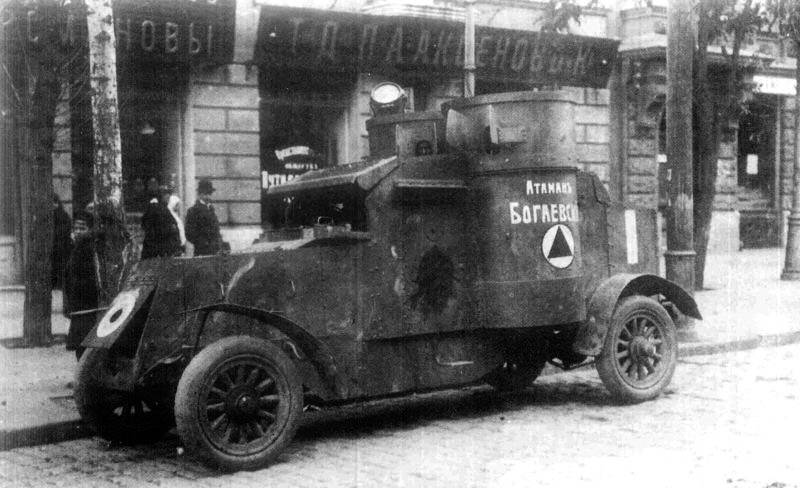
"Ataman Bogaevsky" - the armored car of the Don Army
To be continued ...
Information